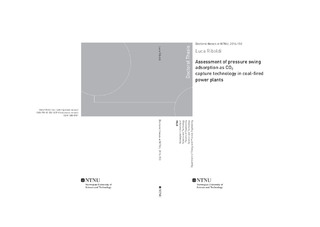| dc.description.abstract | Coal-based power generation is responsible for a significant share of CO2 emissions on
a global scale. Technologies to drastically reduce coal carbon footprint are critical for
meeting mitigation targets. Absorption, whether chemical or physical depending on the
process framework, is commonly regarded as the most mature technology in this
context. Nevertheless, absorption suffers from some drawbacks, such as high energy
requirements and corrosion of process equipment. Adsorption is considered as a
promising alternative, with potential for reducing energy penalty, environmental impact
and cost of CO2 capture.
The main objective of this thesis is to assess the viability of a process relying on
adsorption, i.e. pressure swing adsorption (PSA), as CO2 capture technology in coalfired
power plants.
In order to get a comprehensive overview on the prospects of PSA, different cases were
considered. Post-combustion CO2 capture was studied by integrating a PSA unit into an
advanced supercritical pulverized coal (ASC) plant. Pre-combustion CO2 capture was
studied by integrating a PSA unit into an integrated gasification combined cycle (IGCC)
plant. Proper designs for these process frameworks were defined, taking into account
characteristics, requirements and constraints of the systems. PSA is a discontinuous
process, made of different steps undergone by each column of a PSA train. A dynamic
model was built, based on material, energy and momentum balances. The developed
dynamic model was then linked to the steady-state model of the power plant, by
exploiting appropriate process scheduling and the cyclic steady state (CSS) condition of
the PSA process (a condition in which the process transient behavior becomes steady
throughout different cycles). The resulting composite model allowed performing
simulations and analyses on a system level.
The post-combustion case (ASC + PSA) showed competitive energy performance. The
net electric efficiency obtained was 34.8%, whereas the reference plant without CO2
capture had 45.1%. The CO2 capture requirement was also fulfilled with more than 90%
CO2 sequestrated. A comparison with chemical absorption - performing with 34.2% net
electric efficiency - confirmed the competitiveness of PSA. A serious issue ascertained
concerned the required footprint of the PSA unit. A first estimation suggested the
necessity of more than 260 adsorption columns for processing the entire flue gas
coming from the boiler. The feasibility of PSA in the post-combustion case appeared
less attractive because of the number of vessels needed.
The pre-combustion case (IGCC + PSA) returned good results for all the performance
indicators investigated. A comparison with physical absorption showed that PSA is
slightly outperformed in terms of energy efficiency (36.2% versus 37.1%, with the
reference plant without CO2 capture having 47.3%), CO2 recovery (86.1% versus 90.6%)
and footprint. However, the performance gap was evaluated to be rather small, thus
additional investigations were carried out in this process framework.
Improvements in the performance of the pre-combustion case were sought by
considering two domains, the process and the adsorbent material. Several possible
process configurations were analysed and a range of results obtained. Improved energy
performance could be obtained but to the detriment of the CO2 separation performance
and vice versa. Modifications in the adsorbent material properties (attempting to
simulate different adsorbents and/or advancements in the materials) showed a
significant influence not only on the gas separation process but on the whole plant
performance. The utilization of improved adsorbents demonstrated the capability to give
a substantial contribution to close the gap with absorption, though it may not be
sufficient. None of the cases studied succeeded to fully match absorption-based
performance both in terms of energy and CO2 capture efficiency. Further, an approach
to exploit possible synergies between the two studied domains and realize the full
potential of PSA in this framework was outlined. It consisted of tuning the material
properties according to a specific process configuration. The results achieved were
encouraging as net electric efficiencies up to 37.1% were obtained without drastic
decrease in the CO2 capture efficiency.
The knowledge developed in the pre-combustion process framework suggested a further
case which was believed interesting for PSA. An IGCC plant was defined coproducing
power and ultrapure H2 with CO2 capture. The system is of interest both because it
allows capturing CO2 and because differentiating the plant products can be
advantageous in terms of flexible operation. Two novel process configurations were
developed, entirely relying on PSA. The first consists of two consecutive PSA stages
(Two-train PSA), while the second configuration carries out both CO2 separation and H2
purification within a single PSA stage (One-train PSA). Both these configurations
succeeded to provide a varying power-to-hydrogen output ratio - the net power output
could be reduced from 346 MW to 300 MW by increasing the ultrapure H2 throughput -
with a constant coal feed to the gasifier and retaining plant efficiency on a good level.
The common process design for an IGCC coproduction layout encompasses absorption
for CO2 capture and PSA for H2 production. With regard to that, a comparative analysis
seems to confirm the expected advantages brought by the utilization of PSA as the only
gas separation technology. A higher integration level could be achieved, allowing
significant energy savings. The assessment of PSA in this framework was concluded to
be promising and worth further analyses.
Summing up, it was demonstrated that PSA can be successfully integrated in coal-fired
power plants as CO2 capture technology. However, the analyses carried out showed also
that PSA is generally outperformed by absorption in an overall evaluation taking into
account different performance indicators. Potentials and limits of the technology have
been highlighted and recommendations for optimizing the performance have been
outlined. The knowledge developed can be useful to address further work on PSA
technology, especially in those specific frameworks (e.g. coproduction of power and H2)
where PSA can reach competitiveness. | nb_NO |
